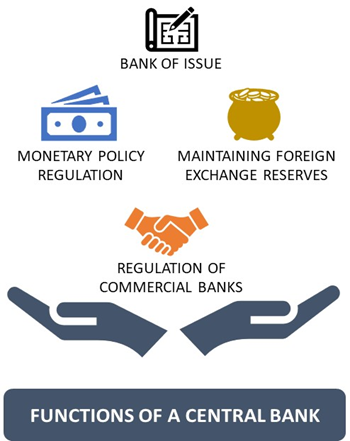What is a central bank?
A central bank is the prime monetary body in a country that oversees the regulation of the monetary policy as well as the functioning of all other banks. A central bank function in the same way as a normal bank does, the difference being the fact that it lends to other financial institutions rather than to the public, and the fact that it has the authority to print the currency.
Central banks are non-commercial banks and do not deal with the public directly. However, the aim of central banks is to facilitate spending and saving of the consumers. Central banks work independently of the government.
Central banks have the sole authority to print currency. This means that the currency published by the central banks cannot be rejected for payment by the citizens of the country. Any currency bill that is used to make a payment is backed by the central banks claim about the value of that bill.
Any mode of payment that is deemed acceptable by the central banks cannot be rejected as payment by anyone in the country.
Why is the central bank important?
The central bank has the responsibility of regulating the financial sector. It performs the following functions:
- Bank of Issue: The central banks have the sole authority in a country to print money. Currency can only be printed against the gold reserves that a country has. Therefore, this is a huge responsibility and requires proper adherence to the guidelines.
If money is printed beyond the permissible level, then it can lead to inflation in an economy which leads to severe downturns in the economy.
- Monetary Policy Regulation: This is one of the most active roles played by the central banks. The monetary policy allows the central banks to inject or withdraw money into the economy. Through this, the supply of money can be controlled depending upon the economic scenario. This is generally achieved through open market operations. Open market operations refer to the buying and selling of government bonds to adjust the liquidity in the market.
For instance, when the government wants to decrease the money supply in the market, then they can sell government bonds. As people purchase these bonds, they are left with left disposable cash. Alternatively, when the government wants to increase the money supply, then they can buy back these bonds from the market, thereby increasing the disposable cash in the hands of the people.
These open market operations are done to influence the interest rates in the economy. This happens through the monetary transmission mechanism. As bonds are released into the market, their price falls. Due to their inverse relationship with prices of bonds, interest rates rise. Therefore, central banks can control interest rates through open market operations
- Regulation of Commercial Banks: Central banks are tasked with managing other commercial banks. The central banks decide the reserve ratio that needs to be maintained by the commercial banks. When this ratio is reduced, it is done to inject money into the economy to boost consumer demand and vice versa.
Central banks also make sure that commercial banks do not fall short of capital. They lend to commercial banks at an interest rate which is called the repo rate. Because of this reason, they are called the “lender of the last resort”. Conversely, the rate at which commercial banks lend to the central bank is called the reverse repo rate.
- Maintaining Foreign Exchange Reserves: Central banks hold all foreign exchange reserves that a country possesses. These reserves are used to maintain the exchange rate. Many countries peg their currencies to another dollar. To maintain this peg, central banks must buy and sell foreign currency.
Currency reserves can also be used to influence the inflation rate in an economy. They can devalue or revalue their currency using these foreign reserves.

Image Source: ©Kalkine Group
How did the idea of a central bank come into existence?
One of the first financial institutions recognized as a central bank was the Swedish Riskbank. This was formed as a joint stock company with the primary purpose to lend government funds and act as a clearing house. Following this, central banks were formed for the issuing of currency and to purchase the government debt.
Most of these early institutions were private entities financing government debt. These central banks also provided loans to other banks and thus gained a position as the lender of the last resort. They held deposits of other banks as well, which helped them provide loans to other banks. These roles were limited to lending in times of need and did not include other macroeconomic positions like maintaining inflation levels and monetary expansion, etc.
The roles associated with central banks started to take a defining shape post World War I. When countries had to manage the problems on unemployment, inflation, they decided to expand the functions of the central bank.
 Please wait processing your request...
Please wait processing your request...